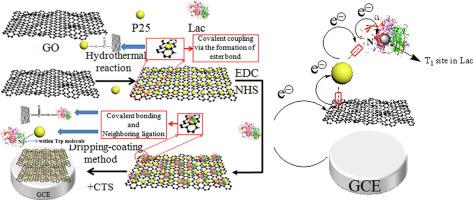Chemical Engineering Journal ( IF 13.3 ) Pub Date : 2021-09-24 , DOI: 10.1016/j.cej.2021.132619 Shu Wei Zhang 1 , Mi Zhang 1 , Fang Wang 1 , Han Zeng 1

|
Nano-complex consisting of Titanium dioxide and graphene oxide via covalent bonding was proposed to be Laccase immobilization matrix through collaborative effect of chemical tethering and adjacent complexation between TiO2 and Laccase molecule. Geometrical feature, structural characteristics and physio-chemical properties of nano-composite with Laccase entrapment were systematically characterized and evaluated. Influences of mutual interactions between element of nano-complex and incorporated protein molecule on kinetics of electro-catalysis and efficiency of photo-electrocatalysis for oxygen reduction of Laccase based electrode were quantitatively analyzed. Results from measurements indicated mutual interactions dominated by adjoining ligation would lead to irregular arrangement of protein molecules on the surface of enzyme carrier and decrease the orderliness of nano-complex with Laccase anchoring with improved hydrophilicity. The combination of Laccase with P25 in nano-complex via the static quenching would enhance the utilization efficiency of external illumination with the crippled band gap (Eg) in the indirect mode (∼1.43 eV for nano-composite with Lac integration). Such combination would alter the route of charge transferring which meant the redox site in TiO2 would play the role of primary electron acceptor and T1 site in coordination with TiO2 of integrated Laccase could perform the duty of intra-molecular electron mediator (apparent heterogeneous electron shuttle rate: 2.6 × 10−3 s−1). Electro-catalytic performance on oxygen reduction for Laccase based electrode was limited by the step of substrate diffusion (in the form of free state and entrapment into nano-complex: 2.9 × 10−4 and 1.8 × 10−6 s−1, respectively). As-prepared Lac case based electrode displayed favorable sensing performance to its substrate-dissolved oxygen: high affinity (KM: 46.4 μmol•L−1), moderate detection limit (0.34 μmol•L−1) and enhanced sensitivity (0.021 μA•L•μmol−1).
中文翻译:

基于二氧化钛-氧化石墨烯纳米复合物与漆酶调节的电极氧还原的直接电化学和酶参与光电催化
通过TiO 2之间的化学束缚和相邻络合的协同作用,提出了由二氧化钛和氧化石墨烯通过共价键合组成的纳米复合物作为漆酶固定基质和漆酶分子。系统地表征和评价了包封漆酶的纳米复合材料的几何特征、结构特征和理化性质。定量分析了纳米复合物元素与掺入的蛋白质分子之间相互作用对电催化动力学和光电催化氧化漆酶基电极氧还原效率的影响。测量结果表明,以相邻连接为主的相互作用将导致酶载体表面蛋白质分子的不规则排列,并降低纳米复合物与漆酶锚定的有序性,提高亲水性。漆酶与 P25 在纳米复合物中通过静态猝灭的结合将提高外部照明的利用效率,间接模式下的带隙(Eg)有缺陷(对于具有 Lac 集成的纳米复合材料,约 1.43 eV)。这种组合会改变电荷转移的途径,这意味着 TiO2 中的氧化还原位点2将起到初级电子受体的作用,T 1位点与集成漆酶的TiO 2配合可以起到分子内电子介体的作用(表观异质电子穿梭率:2.6 × 10 -3 s -1)。漆酶基电极的氧还原电催化性能受到底物扩散步骤的限制(以自由态和捕获到纳米复合物中的形式:分别为 2.9 × 10 -4和 1.8 × 10 -6 s -1) . 所制备的基于 Lac 壳的电极对其底物溶解氧表现出良好的传感性能:高亲和力 (K M : 46.4 μmol•L -1)、中等检测限 (0.34 μmol•L -1 ) 和增强的灵敏度 (0.021 μA•L•μmol -1 )。











































 京公网安备 11010802027423号
京公网安备 11010802027423号